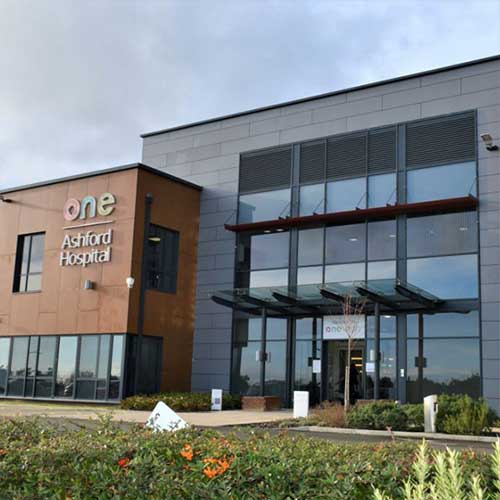Myringoplasty
A myringoplasty, also known as a Type 1 Tympanoplasty, is an operation to repair a large hole (perforation) in the eardrum that has not healed itself within a few weeks. The procedure is generally carried out to improve hearing, avoid recurring infections and to be able to get the ear wet.
What is a Perforated Eardrum?
A perforated eardrum means there is a hole, usually caused by an injury/trauma or infection in the middle ear. In some cases, a hole will heal itself and does not cause any problems. However, it can lead to recurring infections, discharge from the ear and if the hole is large, then you may experience some hearing loss.
Symptoms of a Perforated Eardrum
Some people do not notice any symptoms; however, you may experience symptoms caused by a perforated eardrum or an infection caused by a perforated ear drum. These symptoms may include:
- Earache or pain in the ear
- Hearing loss. Either struggling to hear or your hearing may be slightly muffled
- Tinnitus (ringing in the ear)
- Vertigo (spinning sensation sometimes resulting in sickness)
- Mucus like liquid leaking from the ear
- A high temperature
- Itchy inner ear
These symptoms will normally pass once the eardrum has healed or the infection has been treated.
Causes of a Perforated Eardrum
Your middle and inner ears are made up of delicate structures that are sensitive to injury or disease. Causes of a perforated eardrum may include:
Middle ear infection (otitis media)
This is a middle ear infection that causes inflammation and a build-up of fluid behind the eardrum. Pressure from these fluids can cause the eardrum to rupture.
Barotrauma
Barotrauma is common and is most often caused by increased air or water pressure such as flying or scuba diving. If the pressure is extreme, your eardrum may perforate. A sudden change in pressure can also be caused by a direct blow to the ear.
Loud sounds or blasts (acoustic trauma)
Rarely causing a tear in the eardrum, acoustic trauma can be caused by a sudden loud noise such as an explosion.
Foreign objects in your ear
Small objects, such as a cotton bud if not inappropriately, can perforate and puncture the eardrum.
Severe head trauma
Severe head trauma may cause injury to middle and inner ear structures, including your eardrum.
Diagnosis
Your doctor or ENT specialist can often determine if you have a ruptured (perforated) eardrum with a visual inspection, using a lighted instrument (otoscope- an instrument with a light that is used to look inside the ear or microscope). In some cases, there may be too much wax or fluid for the doctor to see the eardrum clearly; in this case they may clean the ear or prescribe eardrops to help clear it.
The doctor may use a rubber bulb attached to the otoscope to blow a waft of air into the ear. If the eardrum isn’t ruptured, it will move when the air hits it. You may be asked to undergo a hearing test to determine how much the ruptured eardrum has affected your hearing. In most cases, hearing loss caused by a ruptured eardrum is temporary and normal hearing returns after the eardrum has healed.
Your doctor may conduct or suggest other tests to determine the cause of your ear symptoms. These tests include:
Laboratory tests
A medical procedure that will test the discharge and fluid from your ear to detect a bacterial infection.
Tuning fork evaluation
Tests with tuning forks can help your doctor identify hearing loss and may also help reveal where the damages are in the ear.
Tympanometry
A test that measures the function of the middle ear. A device is inserted into your ear canal that calculates the reaction of your eardrum to slight changes in air pressure.
Audiology test
This is a series of strictly calibrated tests that provide an evaluation of the sensitivity of a person’s hearing and how they hear sounds at different volumes and pitches.
Treatment and Procedure
A myringoplasty is usually performed under general anaesthetic and carried out on a day case basis, usually taking between an hour and an hour and a half. During the procedure, a small incision is made behind your ear or above the opening (in some cases your surgeon may need to widen the ear canal to get to the perforation) and a small piece of tissue is removed from under your skin, leaving a small scar. Small surgical tools are then used to cover the hole in your eardrum with this piece of tissue (graft).
A dressing is placed in the ear canal, usually for around 2-3 weeks, to hold the graft in place and stop water and bacteria getting in. The incisions in your skin are closed with stitches and you may have an external dressing and cotton wool held in place with a head bandage following the procedure.
Most people are able to go home the same day following the procedure but you will need to arrange for transport home as you will not be able to drive for 24 hours following the anaesthetic.
Post-Operative Recovery
You will usually be able to go home the same day following the procedure. If a head bandage was used, it should be removed the morning after the surgery. It usually takes a few weeks for your eardrum to heal completely, with a follow-up appointment arranged for around 2-3 weeks after the operation.
You will need to take 2-7 days off work to aid your recovery, with regular exercise helping you return to normal activities as soon as possible (check with your doctor for advice). Myringoplasty is typically not a very painful surgery but if you experience any discomfort you may take over-the-counter pain relief following dosage instructions. Any stitches used will be removed 7 days after the surgery (if they do not dissolve by themselves) and some packs in your ear will be removed when you come in for your follow-up appointment.
Activities to avoid until after your follow-up appointment include:
- Flying
- Swimming
- Sports and other taxing activities
- Smoking
- Contact with sick people
- Blowing your nose too aggressively (if you need to sneeze, try and keep your mouth open to limit the pressure in your ear)
Your doctor will instruct you when you can return to normal activities.
Risks and Complications
Typically, myringoplasty surgery is safe and does not cause any serious problems. You may experience numbness behind the ear, but this is usually only temporary and occurs if an incision was made there. The risks depend on the reason you are undergoing the surgery and any other medical problems you may have. Some risks are extremely rare but serious, whereas others are more common but easily treatable. Possible risks include:
- Bleeding
- A wound infection resulting in pain, bleeding, leaking fluid and inflammation
- Failure to close the perforation in the eardrum. Although extremely rare, there is a small chance the graft will not agree with the eardrum
- Changes in taste. Although these are usually temporary
- Hearing loss. This is extremely rare and would probably be permanent
- Tinnitus. This will generally improve over time, but can occasionally be permanent
- Facial weakness or an inability to move specific facial muscles (permanent in rare cases)
- A reaction to the anaesthetic
It is normal to have some discomfort and unusual noises in your ear for the first few days after surgery. If you develop any further problems or the discomfort does not subside, contact your doctor for advice.
Outlook
A myringoplasty may prevent infections and sometimes improve your hearing. Generally, eardrum repairs are very successful with most patients recovering, with no complications. The result of the surgery may not be as good if the bones of your middle ear need to be repaired as well as your eardrum.
Need Help?
At One Healthcare we can book you in to see a specialist Ear, Nose and Throat surgeon for an initial consultation, usually within 48 hours. Myringoplasty is available at One Ashford Hospital in Kent and One Hatfield Hospital in Hertfordshire.
You can use your private medical insurance or pay for your Myringoplasty treatment. We offer competitive, fixed price packages. If you are using your health insurance, please contact your insurer first for approval and let them know you’d like to be treated at One Hatfield Hospital.
Why One Hatfield
- Modern purpose-built hospital opened in December 2017
- Fast access to diagnostics including MRI, X-ray and Ultrasound
- Private, spacious, en-suite rooms
- Specialist physiotherapy and nursing teams
- Little or no waiting time
- ‘Ultra clean air’ theatres
- Freshly prepared food
- Calm, dignified experience
Contact us and find out more
If you are based in and around Hertfordshire, St Albans, Stevenage, Watford, Barnet, North London, Welwyn or Bedfordshire and would like to visit the One Hatfield Hospital please click here.
ENT (Ear, Nose and Throat) Pricing Guide at One Hatfield Hospital
This is a list of guide prices for some of common ENT (Ear, Nose and Throat) treatments and procedures.
| Treatment | Guide Price |
|---|---|
| Tonsillectomy (Adult) | £3,300 |
| Insertion of Grommet | £2,525 |
| Microsuction | £109.25 |
| Neck Lump Package | £1,500 |



 One Ashford
One Ashford One Hatfield
One Hatfield